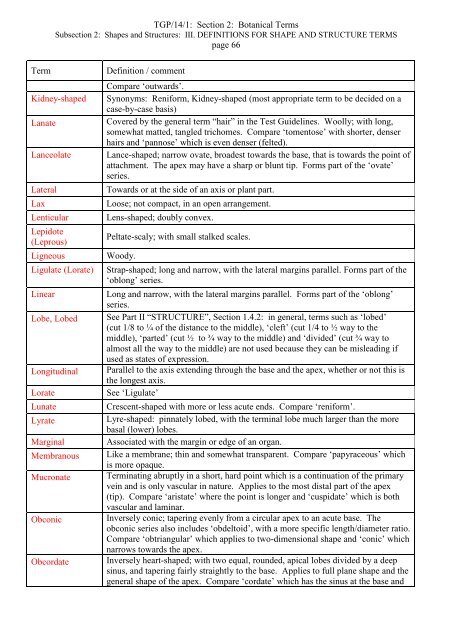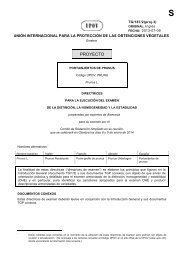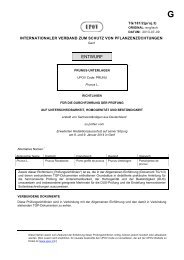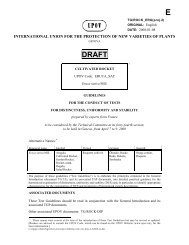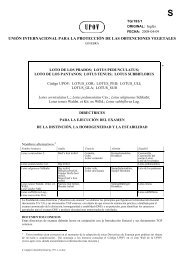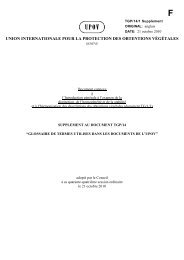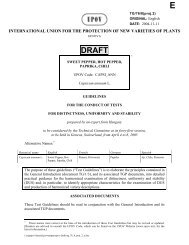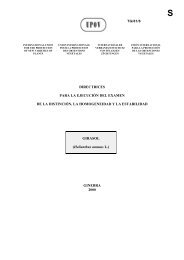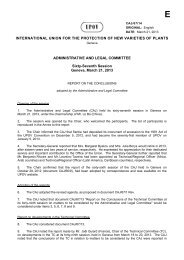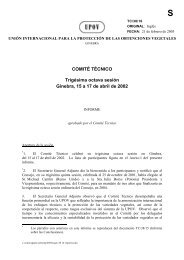E - International Union for the Protection of New Varieties of Plants
E - International Union for the Protection of New Varieties of Plants
E - International Union for the Protection of New Varieties of Plants
Create successful ePaper yourself
Turn your PDF publications into a flip-book with our unique Google optimized e-Paper software.
TGP/14/1: Section 2: Botanical Terms<br />
Subsection 2: Shapes and Structures: III. DEFINITIONS FOR SHAPE AND STRUCTURE TERMS<br />
page 66<br />
Term<br />
Kidney-shaped<br />
Lanate<br />
Lanceolate<br />
Lateral<br />
Lax<br />
Lenticular<br />
Lepidote<br />
(Leprous)<br />
Ligneous<br />
Ligulate (Lorate)<br />
Linear<br />
Lobe, Lobed<br />
Longitudinal<br />
Lorate<br />
Lunate<br />
Lyrate<br />
Marginal<br />
Membranous<br />
Mucronate<br />
Obconic<br />
Obcordate<br />
Definition / comment<br />
Compare ‘outwards’.<br />
Synonyms: Reni<strong>for</strong>m, Kidney-shaped (most appropriate term to be decided on a<br />
case-by-case basis)<br />
Covered by <strong>the</strong> general term “hair” in <strong>the</strong> Test Guidelines. Woolly; with long,<br />
somewhat matted, tangled trichomes. Compare ‘tomentose’ with shorter, denser<br />
hairs and ‘pannose’ which is even denser (felted).<br />
Lance-shaped; narrow ovate, broadest towards <strong>the</strong> base, that is towards <strong>the</strong> point <strong>of</strong><br />
attachment. The apex may have a sharp or blunt tip. Forms part <strong>of</strong> <strong>the</strong> ‘ovate’<br />
series.<br />
Towards or at <strong>the</strong> side <strong>of</strong> an axis or plant part.<br />
Loose; not compact, in an open arrangement.<br />
Lens-shaped; doubly convex.<br />
Peltate-scaly; with small stalked scales.<br />
Woody.<br />
Strap-shaped; long and narrow, with <strong>the</strong> lateral margins parallel. Forms part <strong>of</strong> <strong>the</strong><br />
‘oblong’ series.<br />
Long and narrow, with <strong>the</strong> lateral margins parallel. Forms part <strong>of</strong> <strong>the</strong> ‘oblong’<br />
series.<br />
See Part II “STRUCTURE”, Section 1.4.2: in general, terms such as ‘lobed’<br />
(cut 1/8 to ¼ <strong>of</strong> <strong>the</strong> distance to <strong>the</strong> middle), ‘cleft’ (cut 1/4 to ½ way to <strong>the</strong><br />
middle), ‘parted’ (cut ½ to ¾ way to <strong>the</strong> middle) and ‘divided’ (cut ¾ way to<br />
almost all <strong>the</strong> way to <strong>the</strong> middle) are not used because <strong>the</strong>y can be misleading if<br />
used as states <strong>of</strong> expression.<br />
Parallel to <strong>the</strong> axis extending through <strong>the</strong> base and <strong>the</strong> apex, whe<strong>the</strong>r or not this is<br />
<strong>the</strong> longest axis.<br />
See ‘Ligulate’<br />
Crescent-shaped with more or less acute ends. Compare ‘reni<strong>for</strong>m’.<br />
Lyre-shaped: pinnately lobed, with <strong>the</strong> terminal lobe much larger than <strong>the</strong> more<br />
basal (lower) lobes.<br />
Associated with <strong>the</strong> margin or edge <strong>of</strong> an organ.<br />
Like a membrane; thin and somewhat transparent. Compare ‘papyraceous’ which<br />
is more opaque.<br />
Terminating abruptly in a short, hard point which is a continuation <strong>of</strong> <strong>the</strong> primary<br />
vein and is only vascular in nature. Applies to <strong>the</strong> most distal part <strong>of</strong> <strong>the</strong> apex<br />
(tip). Compare ‘aristate’ where <strong>the</strong> point is longer and ‘cuspidate’ which is both<br />
vascular and laminar.<br />
Inversely conic; tapering evenly from a circular apex to an acute base. The<br />
obconic series also includes ‘obdeltoid’, with a more specific length/diameter ratio.<br />
Compare ‘obtriangular’ which applies to two-dimensional shape and ‘conic’ which<br />
narrows towards <strong>the</strong> apex.<br />
Inversely heart-shaped; with two equal, rounded, apical lobes divided by a deep<br />
sinus, and tapering fairly straightly to <strong>the</strong> base. Applies to full plane shape and <strong>the</strong><br />
general shape <strong>of</strong> <strong>the</strong> apex. Compare ‘cordate’ which has <strong>the</strong> sinus at <strong>the</strong> base and


